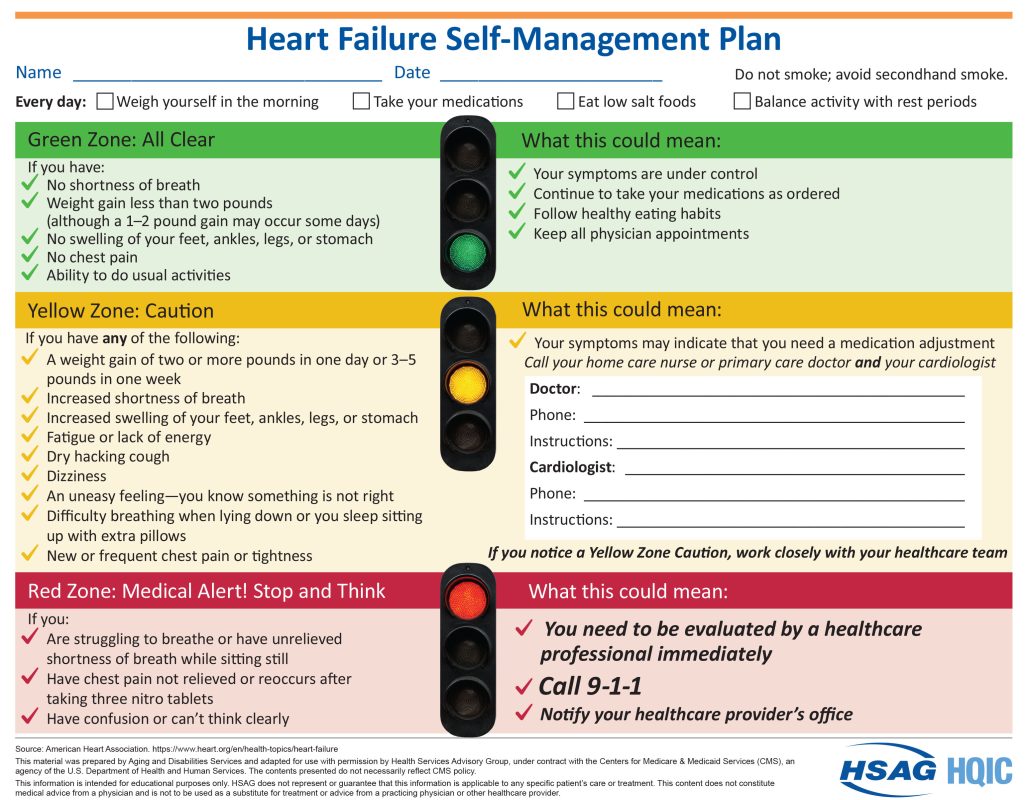Introduction
Living with heart failure means becoming an active participant in your own care. While it can feel overwhelming, having a clear, actionable plan is the key to staying healthy, reducing hospital visits, and enjoying a better quality of life.
One of the most effective tools for this is the Heart Failure Self-Management Plan, often called the “Traffic Light” guide. This simple, color-coded system from the American Heart Association and HSAG/HQIC makes it easy to monitor your condition daily and know exactly when to take action.
Here is a breakdown of the three vital zones and what each one means for you.

🟢 Green Zone: All Clear – Stay the Course
The Green Zone is your goal—it means your heart failure is well-managed, and your symptoms are stable.
If you are in the Green Zone, you should have:
- No shortness of breath.
- Weight gain of less than two pounds (though minor daily fluctuations are normal).
- No swelling in your feet, ankles, legs, or stomach.
- No chest pain.
- The ability to do your usual daily activities.
What This Means: Your current treatment plan and lifestyle habits are working! Continue taking your medications as ordered, weigh yourself every morning, follow a low-salt diet, and keep all scheduled physician appointments. This is the time to maintain your routine and enjoy your healthy activity level.
🟡 Yellow Zone: Caution – Time to Call the Doctor
The Yellow Zone is a warning sign. It means your symptoms are changing, and your condition is becoming less stable. This is your prompt to call your healthcare provider or home care nurse immediately. Do not wait for things to get worse.
You are in the Yellow Zone if you have ANY of the following:
- A weight gain of two or more pounds in one day or 3–5 pounds in one week.
- Increased shortness of breath.
- Increased swelling of your extremities (feet, ankles, legs) or stomach.
- Fatigue or a noticeable lack of energy.
- A dry, hacking cough.
- Dizziness.
- An uneasy feeling that tells you something is not quite right.
- Difficulty breathing when lying down, requiring you to sleep sitting up with extra pillows.
- New or frequent chest pain or tightness.
What This Means: The appearance of a Yellow Zone symptom suggests you likely need a medication adjustment—such as an increase in your diuretic (water pill) dose. Contact your doctor, nurse, or cardiologist right away to discuss your changes. They will provide specific instructions for medication adjustments and monitoring.
🔴 Red Zone: Medical Alert! Stop and Think
The Red Zone is a medical emergency. These symptoms indicate a serious and immediate threat to your health, and you need urgent professional care.
You are in the Red Zone if you are:
- Struggling to breathe or have unrelieved shortness of breath while sitting still.
- Experiencing chest pain that is not relieved or reoccurs after taking three nitroglycerin tablets (if applicable).
- Experiencing confusion or inability to think clearly.
What This Means: You need to be evaluated by a healthcare professional immediately.
- Call 9-1-1 (or your local emergency number).
- Notify your healthcare provider’s office as soon as possible.
Your Daily Action Plan
Self-management is a daily commitment. By incorporating a few simple steps into your routine, you can effectively monitor your health and stay in the Green Zone:
- Daily Weight Check: Weigh yourself every morning, at the same time, wearing similar clothing. Record this number.
- Medication Adherence: Take all your prescribed medications exactly as ordered.
- Low-Salt Diet: Stick to a low-salt, heart-healthy diet to manage fluid retention.
- Balance Activity: Find the right balance between physical activity and rest periods.
- Avoid Tobacco: Do not smoke, and avoid secondhand smoke.
By understanding and following this “traffic light” plan, you empower yourself to live successfully with heart failure, knowing that you have a clear roadmap for every step of your health journey.
Disclaimer
This blog post is for informational and educational purposes only. The Heart Failure Self-Management Plan is a general guide and is not a substitute for professional medical advice, diagnosis, or treatment from a qualified healthcare provider.
If you are in the Red Zone or are experiencing a medical emergency, call 9-1-1 immediately. Always seek the advice of your physician, cardiologist, or other qualified health provider with any questions you may have regarding a medical condition or before starting any new treatment. Reliance on any information appearing in this article is solely at your own risk.
Source Citation
This blog post is based on the Heart Failure Self-Management Plan developed by the American Heart Association and adapted for use by Health Services Advisory Group (HSAG) under contract with the Centers for Medicare & Medicaid Services (CMS).
Primary Source Reference:
- American Heart Association: https://www.heart.org/en/health-topics/heart-failure
- The HOPE Note: Transforming Primary Care with Integrative Health
- Essential Guide to LGBT Caregiving: Challenges, Steps & Resources
- Carrying on a Legacy of Love: The “Bread Run” with Sister Joyce and The Crew
- Stop the Bite: Bedbug Detection, Prevention, and Treatment
- Common Warning Signs of Mental Health: A Guide for Families and Caregivers


